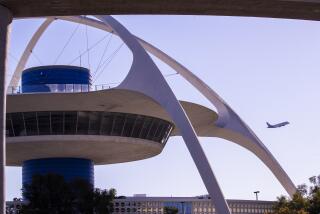Jet Averts Phantom Midair Crash
- Share via
A Southwest Airlines jet was making a routine approach to Burbank Airport last week when an alarm shattered the calm in the cockpit, warning that a possible midair collision was imminent.
The warning came from an on-board, computerized radar device--the Traffic alert and Collision Avoidance System, known as TCAS--designed to notify the cockpit crew if the plane appears to be on a course that will take it dangerously close to another aircraft.
The device tells the crew what evasive action to take. In this case, it told the pilots to climb and turn to the right, which they did.
The crew then called air traffic control to ask where the other plane was, Southwest spokeswoman Kirsten Kendrick said. She said the controllers responded that there actually were two other planes flying in the area--both of them smaller, propeller-driven aircraft--but neither appeared dangerously close.
Southwest’s Flight 1451, a twin-engine Boeing 737 carrying 56 passengers and a crew of five, then landed without incident at Burbank.
But a question remained: Why had the alarm sounded?
Kendrick said Thursday that federal investigators determined that the system had been activated by an aircraft transmitter being tested on the ground at Van Nuys Airport--directly under Flight 1451’s path.
As officials reconstructed the event, Flight 1451 had taken off from Las Vegas on the morning of Jan. 9, flew west to the Simi Valley area and made a U-turn, lining up for a west-to-east landing on Burbank’s Runway 8.
Mitch Barker, a spokesman for the Federal Aviation Administration, said the jetliner was about two miles west of the airport, descending through 3,000 feet, when the alarm went off about 10:50 a.m.
Kendrick said the transmitter that apparently triggered it was a transponder, a device to enhance a plane’s image on radar screens, adding a readout of its altitude and an identification code. Transponders normally are not turned on until after takeoff.
Barker said that at the time the alarm sounded on Flight 1415, one of the other aircraft aloft--an air taxi--was about two miles east of Burbank Airport at an altitude of 4,000 feet. He said the third aircraft, a twin-engine Ameriflight air freight plane, was at 5,000 feet.
Responding to the directions from TCAS, Flight 1451 turned south and climbed to 4,600 feet.
Kendrick said that none of the planes came dangerously close to one another.
Nonetheless, Kendricks said the pilot of the air freight plane reported that his craft was “bounced around a bit” as it apparently descended somewhat and crossed the wake of the Boeing jetliner a short time later.
John Hazlett, an Ameriflight official, described the incident as noneventful and denied that the plane had been buffeted by wake turbulence.
Encounters with wake turbulence, which can last for several minutes behind a large plane, are not that unusual in crowded airspace. The turbulence, when dangerously strong, can upset smaller aircraft, and pilots of light planes are warned to avoid it when possible.
Times staff writer Martha Willman contributed to this story.
More to Read
Sign up for Essential California
The most important California stories and recommendations in your inbox every morning.
You may occasionally receive promotional content from the Los Angeles Times.













